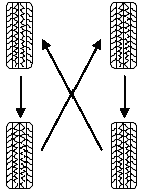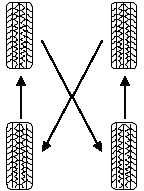|

Safe operation of your vehicle
requires that your tires are
properly inflated. Remember that a
tire can lose up to half of its air
pressure without appearing flat.
Every day before you drive, check
your tires. If one looks lower than
the others, use a tire gauge to
check pressure of all tires and
adjust if required.
At least once a month and before
long trips, inspect each tire and
check the tire pressure with a tire
gauge (including spare, if
equipped). Inflate all tires to the
inflation pressure recommended by
car manufacturer.
When checking the air pressure in
your tires, make sure that you
carefully attach the air pressure
gauge/air hose to the tire’s valve
stem directly on top of the valve
stem. If you bend the valve stem, it
may become damaged and cause an air
leak.
Use a tire gauge to check the tire
inflation pressure, including the
spare (if equipped), at least
monthly and before long trips. You
are strongly urged to buy a reliable
tire pressure gauge, as automatic
service station gauges may be
inaccurate.
Use the recommended cold inflation
pressure for optimum tire
performance and wear.
Under-inflation or over-inflation
may cause uneven treadwear patterns.
Under-inflation is the most common
cause of tire failures and may
result in severe tire cracking,
tread separation or "blowout", with
unexpected loss of vehicle control
and increased risk of injury.
Under-inflation increases sidewall
flexing and rolling resistance,
resulting in heat buildup and
internal damage to the tire. It also
may result in unnecessary tire
stress, irregular wear, loss of
vehicle control and accidents. A
tire can lose up to half of its air
pressure and not appear to be flat!
Always inflate your tires to the car
manufacturers recommended inflation
pressure even if it is less than the
maximum inflation pressure
information found on the tire. Often
the recommended tire inflation
pressure is found on the
certification label which is located
on the edge of the driver’s door or
in the owners manual.
Failure to follow the tire pressure
recommendations can cause uneven treadwear patterns and adversely
affect the way your vehicle handles.
Maximum Permissible Inflation
Pressure is the tire manufacturer's
maximum permissible pressure and/or
the pressure at which the maximum
load can be carried by the tire.
This pressure is normally higher
than the manufacturer’s recommended
cold inflation pressure which can be
found on either the tire label or
certification label. The cold
inflation pressure should never be
set lower than the recommended
pressure on the certification label.
When weather temperature changes
occur, tire inflation pressures also
change. A 10° F (6° C) temperature
drop can cause a corresponding drop
of 1 psi (7 kPa) in inflation
pressure. Check your tire pressures
frequently and adjust them to the
proper pressure which can be found
on the tire label or certification
label.
If you are checking tire pressure
when the tire is hot (i.e. driven
more than 1 mile [1.6 km]), resist
“bleed” or reduce air pressure. The
tires are hot from driving and it is
normal for pressures to increase
above recommended cold pressures. A
hot tire at or below recommended
cold inflation pressure could be
significantly under-inflated.
To check the pressure in your tire(s):
|
|
1. |
Make
sure the tires are cool,
meaning they are not hot
from driving even a mile.
Note: If you have to drive a
distance to get air for your
tire(s), check and record
the tire pressure first and
add the appropriate air
pressure when you get to the
pump. It is normal for tires
to heat up and the air
pressure inside to go up as
you drive. Never “bleed” or
reduce air pressure when
tires are hot. |
|
|
2. |
Remove the cap from the
valve on one tire, then
firmly press the tire gauge
onto the valve and measure
the pressure. |
|
|
3. |
Add
enough air to reach the
recommended air pressure
Note: If you overfill the
tire, release air by pushing
on the metal stem in the
center of the valve. Then
recheck the pressure with
your tire gauge. |
|
|
4. |
Replace the valve cap. |
|
|
5. |
Repeat this procedure for
each tire, including the
spare.
Note: Some spare tires
require higher inflation
pressure than the other
tires. |
|
|
6. |
Visually inspect the tires
to make sure there are no
nails or other objects
embedded that could poke a
hole in the tire and cause
an air leak. |
|
|
7. |
Check
the sidewalls to make sure
there are no gouges, cuts or
bulges. |
Inspecting
Your Tires

Periodically inspect the tire treads
for uneven or excessive wear and
remove objects such as stones, nails
or glass that may be wedged in the
tread grooves. Check for holes or
cuts that may permit air leakage
from the tire and make necessary
repairs. Also inspect the tire
sidewalls for cracking, cuts,
bruises and other signs of damage or
excessive wear. If internal damage
to the tire is suspected, have the
tire demounted and inspected in case
it needs to be repaired or replaced.
For your safety, tires that are
damaged or show signs of excessive
wear should not be used because they
are more likely to blow out or fail.
Improper or inadequate vehicle
maintenance can cause tires to wear
abnormally. Inspect all your tires,
including the spare, frequently, and
replace them if one or more of the
following conditions exist:
Tire Wear

 When
the tread is worn down to 1/16th of
an inch (2 mm), tires must be
replaced to help prevent your
vehicle from skidding and
hydroplaning. Built-in treadwear
indicators, or “wear bars”, which
look like narrow strips of smooth
rubber across the tread will appear
on the tire when the tread is worn
down to 1/16th of an inch (2 mm).
When the tire tread wears down to
the same height as these “wear
bars”, the tire is worn out and must
be replaced. When
the tread is worn down to 1/16th of
an inch (2 mm), tires must be
replaced to help prevent your
vehicle from skidding and
hydroplaning. Built-in treadwear
indicators, or “wear bars”, which
look like narrow strips of smooth
rubber across the tread will appear
on the tire when the tread is worn
down to 1/16th of an inch (2 mm).
When the tire tread wears down to
the same height as these “wear
bars”, the tire is worn out and must
be replaced.
Damage

Periodically inspect the tire treads
and sidewalls for damage (such as
bulges in the tread or sidewalls,
cracks in the tread groove and
separation in the tread or
sidewall). If damage is observed or
suspected have the tire inspected by
a tire professional. Tires can be
damaged during off-road use, so
inspection after off-road use is
also recommended.
Federal law requires tire
manufacturers to place standardized
information on the sidewall of all
tires. This information identifies
and describes the fundamental
characteristics of the tire
Click Here
For Information How To Read Your
Tire.
It is important to equipped your
vehicle with tires designed to
provide a safe ride and handling
capability. Consult with the
professionals at Abbsry New & Used
Tires to ensure your old tires are
properly replaced.
It is recommended that the two front
tires or two rear tires generally be
replaced as a pair.
Safety
Practices

Driving Habits have a great deal to
do with your tire mileage and
safety.
•
Observe
posted speed limits
•
Avoid
fast starts, stops and turns
•
Avoid
potholes and objects on the road
•
Do not
run over curbs or hit the tire
against a curb when parking
If your vehicle is stuck in snow,
mud, sand, etc., do not rapidly spin
the tires; spinning the tires can
tear the tire and cause an
explosion. A tire can explode in as
little as three to five seconds.
Never spin the tires in excess of
the 35 mph (55 km/h) point indicated
on the speedometer.
Highway
Hazards

No matter how carefully you drive
there’s always the possibility that
you may eventually have a flat tire
on the highway. Drive slowly to the
closest safe area out of traffic.
This may further damage the flat
tire, but your safety is more
important.
If you feel a sudden vibration or
ride disturbance while driving, or
you suspect your tire or vehicle has
been damaged, immediately reduce
your speed. Drive with caution until
you can safely pull off the road.
Stop and inspect the tires for
damage. If a tire is under-inflated
or damaged, deflate it, remove wheel
and replace it with your spare tire
and wheel. If you cannot detect a
cause, have the vehicle towed to the
nearest repair facility or tire
dealer to have the vehicle
inspected.
Tire and
Wheel Alignment

A bad jolt from hitting a curb or
pothole can cause the front end of
your vehicle to become misaligned or
cause damage to your tires. If your
vehicle seems to pull to one side
when you’re driving, the wheels may
be out of alignment. Abbsry Tire has
qualified technicians to check the
wheel alignment on your car. Wheel
misalignment in the front or the
rear can cause uneven and rapid
treadwear of your tires and should
be corrected by a qualified
technician. Front wheel drive (FWD)
vehicles and those with an
independent rear suspension (if
equipped) may require alignment of
all four wheels.
The tires should also be balanced
periodically. An unbalanced tire and
wheel assembly may result in
irregular tire wear.
Tire
Rotation

Rotating your tires at the
recommended interval (as indicated
in the scheduled maintenance
information that comes with your
vehicle) will help your tires wear
more evenly, providing better tire
performance and longer tire life.
Unless otherwise specified, rotate
the tires approximately every 5,000
miles (8,000 km).
|
 |
|
 |
|
Front
Wheel Drive (FWD) vehicles
(front tires at top of
diagram) |
|
Rear
Wheel Drive (RWD)
vehicles/Four Wheel Drive
(4WD)/All Wheel Drive (AWD)
vehicles (front tires at top
of diagram) |
Sometimes irregular tire wear can be
corrected by rotating the tires.
Note: The above content is for
information purposes only and not
meant to replace the opinion of a
trained professional. Please consult
with an Abbsry Tire Proffessional.
Information Source: CAV Group and
Ford Motors |